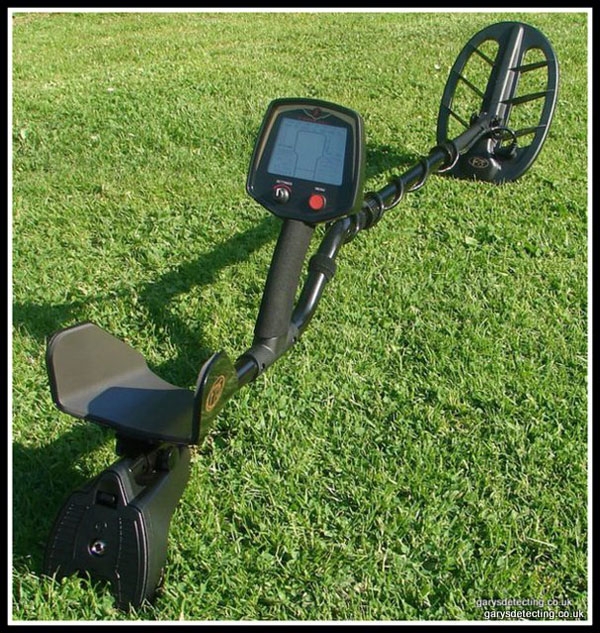 |
Ok so what gives the Fisher F75 SE it's reputation ?
Those who know me are aware I very often detect with friends who have Fisher F75's, they always manage to find something...quite often silver or a nice artefact. For some time I simply put that down to luck, but these guy's can't be lucky all the time, there must be a reason for their success.
I wanted to know why they were regularly getting results, and what makes this machine so rewarding to its operator, I guess your reading this thinking ok here we go another brilliant review, but I am genuinely writing this paragraph without so much as picked the machine up for field use.
I am a genuine believer that all metal detectors do basically the same job, and the key to many peoples success is simply that the machine they use suits their style of detecting...if you like it fits them like a glove, the sounds, the feel, the balance all contribute to a trouble free detecting experience.
So back to my original question, what makes the F75 se so successful
Is it raw power ? if so it's pure magic as it only runs on 4AA batteries, could it be the specially tuned 2D search coil |
|
|
The Fisher F75 special edition build quality and features
The build quality has not really changed since the original F75 and to be honest can not really be faulted, personally I would have wanted improved stem locking collars but they appear to be sufficient, the Black colour scheme makes all the difference and adds a more professional feel to the machine.
The Fisher F75 special edition has eight different tone settings and six different processes
Tone settings Vs Processes
Tone settings will allow you to adjust how the machine sounds over different targets, Processes control how the machine reacts and performs under different search scenario's for example ;
Tone options :
1 Mono...Single tone with no variation.
1F Single tone with vco (voltage controlled oscillator) which varies in pitch depending on signal strength.
2F 2 tone, iron will give a low pitch good targets will give a higher vco tone.
3H 3 tone, also nickels give a tell tale high tone.
3 3 tones Low, Medium and High depending on target conductivity.
4H 4 tone ,again nickels give a high tone.
4 Similar to 3 but has a 4th medium tone.
DP multi tone, the pitch varies depending on the screen number. |
Process options
DE Default mode and works well in most conditions, good for areas with high EMI
JE Jewellery mode very sensitive to low conductive targets ideal for site work * see notes
BC Audio is modified to give a broken sound on bottle caps, not ideal for site hunting
PF Ploughed field mode, the machine will be more settled on uneven ground
BP The Boost Process increases depth and will enhance deep targets NEW
CL Cache Locating mode is designed to find large deep objects and has a slower reaction speed NEW
* Note : Different processes may require a different discrimination and sensitivity setting, for example on my contaminated site I could use a sensitivity of 70 in PF mode, but only a maximum of 35 in JE mode without loosing any performance. |
Once in the Process menu, keep pressing the red button to scroll through the different processes, press the rotary control and return to the detect screen
The notch feature
Most of the time we will never require the notch here in the UK unless hunting in parks, however there is a little glitch you should know about, you must make sure the notch is disabled, the notch screen will always read 1 on it's minimum setting but this does not mean the notch is off...Here's how to tell.
First ensure your machine is in zero discrimination, then look at the screen if it looks like the picture on the left your notch is disabled, if it's like the picture on the right it is enabled (note the Iron has a slash across it)
Notch off
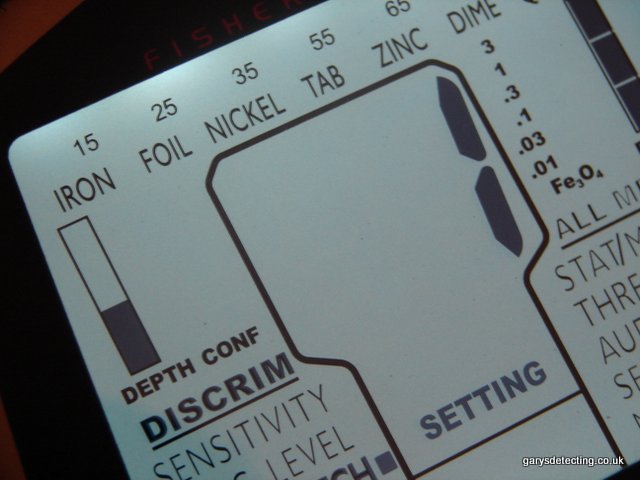 |
Notch on
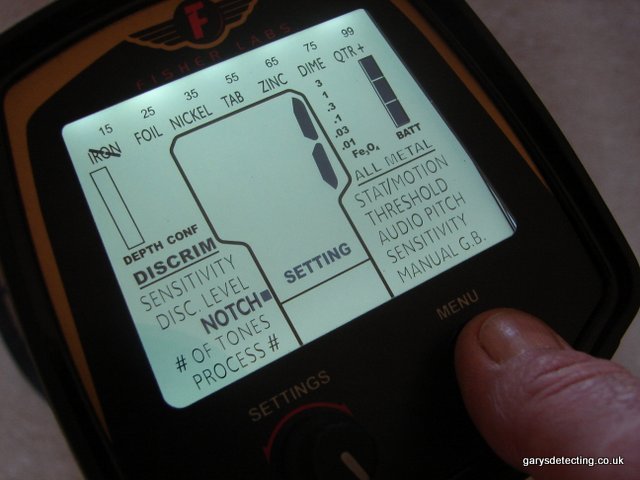 |
When scrolling through the menu and reach notch it activates as soon as you turn the control, but it won't de activate when you turn it back, you can either scroll through the menu again and quickly turn the control left to right as soon as you hit "notch" or the easier way is to factory re set by holding the button in and pushing the trigger forward then turn the machine on, notch will then be disabled.
Discrimination settings and ground balance for in land hunting
Auto grab then plus 3 !
Before you start detecting you are advised to ground balance the machine, you can use auto grab or adjust manually, to auto grab just find a spot with no iron, push the trigger forward and hold, then raise and lower the coil until you hear a stable threshold.
To manually ground balance, switch the cursor to the right hand menu and scroll down to ground balance, raise and lower the coil and make adjustments using the rotary control, advanced users suggest ground balancing in zero discrimination for optimum performance, others suggest use fast grab, then switch to manual and raise it three positions.
Discrimination
It appears that between 11 and 13 are the key numbers, this offers enough iron rejection without sacrificing performance. for some reason the machine appears to be more sensitive with discrimination at 12 compared to discrimination at 6 in JE mode
Push trigger forward for fast grab
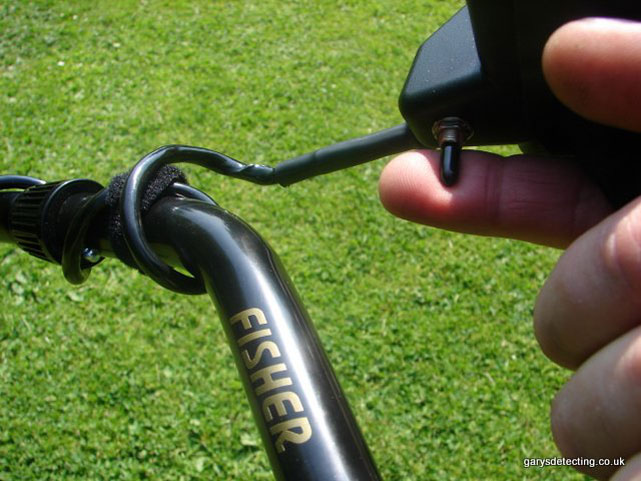 |
Discrimination at 12 appears to be a good setting
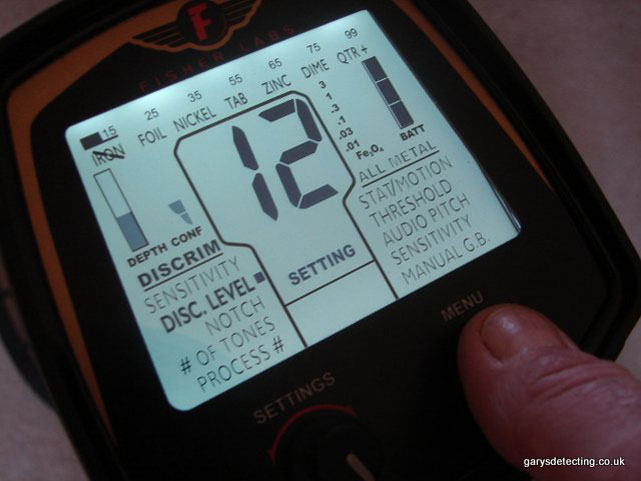 |
FE03 04 meter This is a great feature it tells you how mineralised your soil is or to be exact the amount of magnetic mineralisation, a low to medium soil mineralisation will show no indication, a high reading will show a series of black bars, to get an accurate reading it is best to raise and lower the coil above the soil and watch the meter.
Reducing EMI and changing frequencies
The F75 is a very sensitive machine and at some time you will encounter high levels of EMI (Electronic Magnetic Interference) from other machines. power lines, radio masts etc, if the machine becomes unstable you will need to select a different frequency channel.
Shifting frequencies is very easy to do simply push the trigger forward and press the select button, you will see an "F" number displayed, to select another channel repeat the same procedure until the machine settles, lowering the sensitivity will also help reduce EMI
Changing frequencies
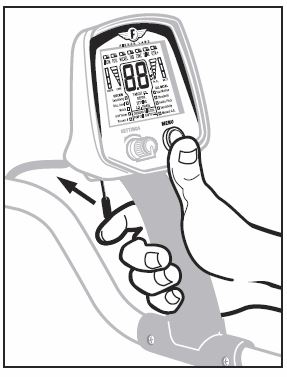 |
Factory re-set procedure
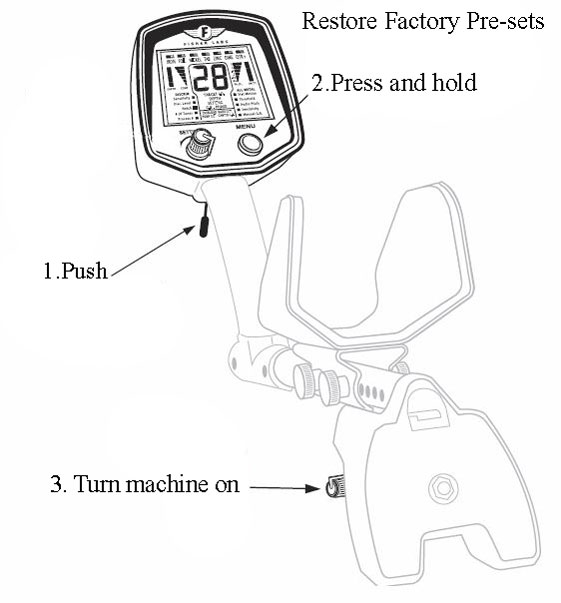 |
That's the basic F75 SE info now let's get out into the field and see how it performs
Fisher F75 SE field review
Out in the field
Out first two tests required the small 5" DD coil, the first site was a patch of land heavily in crop, with small bare patches where it had failed, these were our target area's. Recently I have made some video's of machines using small coils on this very same strip of land, so anything found would be a bonus.
As you can see Aaron had a very limited area to search but we still managed to get some interesting targets ranging form 12 bore pellets to large coin sized pieces of lead that gave a booming signal at around six inches, our best find was a small thin Jetton which again was a ringing signal.
Our second trip out was purely by chance, we got a call from a local Archaeologist team wanting us to search some trenches at short notice, it was another ideal time to test the small coil.
Again the F75 was very adaptable and coped easily with the tasks put before it, using all metal and watching the screen numbers gave us a very good idea of the targets in the trenches, so it's a massive thumbs up for the 5" coil.
How deep is the Fisher F75 SE ?
They say pictures are better than a thousand words, so a video is conclusive proof, I must apologise for the poor sound there was a freak wind storm, normally I would have trashed the video but there was so much interesting footage I felt it was worth up loading, just click on the picture below to watch the video test

Fisher F75 se video
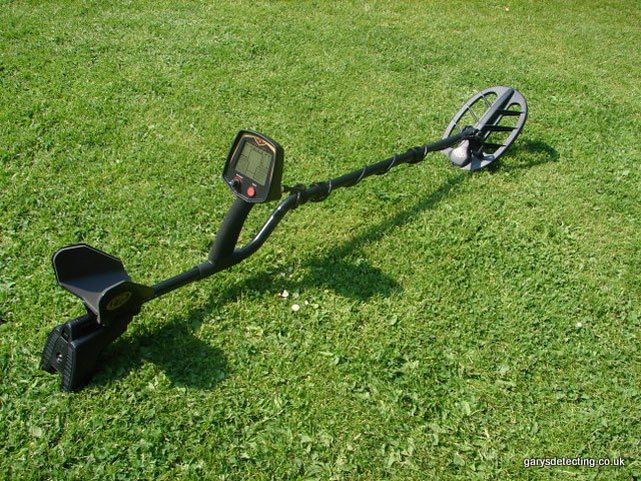
Fisher F75 review by Dave Corsey Fisher F75 SE new user review
DESIGN AND FEEL
Picking up the F75 se for the first time I could see it was a purposeful piece of kit and was inspired to crack on with some field testing.
The overall feel and balance felt it was light enough to swing all day long, I could sense this machine was going to be fun. The design and ergonomics is very focused for the job in hand compared to some other brands I have recently tested.
The control unit looks tidy and meaningful with a very well thought out display; everything is clearly displayed, as a new user I found it quick and easy to understand.
I felt that a nice little design touch was the ability to squeeze the arm cup at the sides to make for a more comfortable grip round the back of your arm, also open it up a little to accommodate a thick jacket sleeve on those colder days.
No need for a strap as this machine is balanced well enough so you never feel the arm cup drop away from the back of your arm or slop around.
The three piece stem is sturdy and accompanied by camlocks, so providing assembled correctly you will have no stem wobble even in amongst the hard stubble.
Holding the firm durable grip on the F75 se felt like it gave more control with each swing, some detectors I have tried in the past feel a little awkward due to having a soft thicker grip that twists while swinging, these soft grips makes a detector feel a little sloppy and over nose heavy and loose.
The F75 only uses 4 aa batteries, some might think that this detector hasn’t the power or stamina to get the job done, Think Again !.
GROUND BALANCING
This is as simple as finding a quiet spot on the ground free of any metallic items and then pumping the coil up and down 4-5 times while the trigger is pushed forward.
This method is called FAST GRAB
You just need to listen out for the audio to become even, so as you raise the coil up off the ground around 6 inches you’ll hear a slight hum and lowering the coil about an inch from the ground until you hear an even audio tone response on the up and down.
If the F75 se couldn’t be ground balanced for any reason you will be told on the display that it can’t ground balance.
In this case the ground is too harsh or a large metallic item lies beneath the coil while balancing.
For the more experienced detectorist manual ground balance is also available if need be.
There is also a ground mineralization indicator on the display if you need to know for any reason the properties of the ground itself.
SEARCH COILS
The two coils that I was able to test was the standard biaxial 11”coil and the 5” round DD coil.
11” BIAXIAL COIL
This coil looks very stylish indeed unlike a lot of bland standard coils fitted to today’s detectors.
Most people want to cover ground fast and the 11”coil will help you do this effortlessly. It is by far one of the lightest coils that I have ever held and is of good quality build and design.
A sharp responsive deep seeking coil, what more do you need from a standard coil
Personally I felt that there would be no need to have a larger coil as it provided great depth and good separation, the standard coil is good enough in my eyes for many terrains.
5” ROUND DD COIL
This is a great addition for the FISHER F75 se, very deep seeking for a small coil and great recovery, all bundled together in a light weight small package.
If your fields are overgrown or still in full bloom then fit this coil on and start searching them, I found it perfect for hedgerows and woodlands to maximise finds potential.
My second signal on my first outing with this great coil turned out to be a silver sixpence around 5” down in a small woodland.
I also found other relic type items that gave good sharp audio responses.
This is such a versatile sensitive coil, you literally can use it anywhere within reason, I even found myself hunting big iron infested fields due to its excellent target separation, I was quite impressed how my finds rate went up with a coil of this size.
I found myself walking very slowly and methodically sweeping the ground as if it was shading in a picture with a pencil and getting great results.
With the bigger coils you are limited in certain areas but this has no limitations when tight spaces come in to play.
I even managed to get this coil into a burnt out tree trunk and still swing left and right.
A brilliant coil and a must have in my opinion.
There are many aftermarket coils available so I’m sure you will find the right coil that suites your style of hunting and needs.
MODES AND TONES
DEFAULT
DE MODE
DE is your basic pre-set default setup mode; I found this mode worked very well in the local parks for general hunting without being twitchy or over sensitive, I found this a very adequate mode and was happy to plod around the park cherry picking stable items.
The recovery speed is very fast, “nipping” from one target to another was quite effortless in this mode.
JEWELLERY
JE MODE
This is the mode I did most of my hunting with as I found it very sensitive, it is very confidence inspiring, I felt that I was missing nothing within reach of the coil.
JE mode also gave very good depth, and I believe JE mode gave me a little more separation of deeper targets than DE mode.
BOTTLE CAP
BC MODE
This can be an awkward mode depending on the hunting environment in my opinion. It works well but will always leave’s you scratching your head thinking what if ?
The mode breaks up steel bottle tops but I found only at around 3-4 inches under the surface, any bottle cap closer it appeared to make no difference.
The awkward part I found with this mode is that if two different kinds of metals are next to each other it appeared to make the signal jump around, this leaves you thinking is it a bottle cap or two metals close together.
For instance you might have a nice silver coin next to a piece of foil that will also make the numbers and audio jump around… bottle cap or not, you’ll have to dig to ease your mind.
In a new park say next to a new housing estate when you are only modern coin hunting this maybe the mode for you and then you can dig those deeper stable signals without the fear that you might be missing old items.
The condition of the bottle top plays around with audio and numbers also.
I also found in BC mode the recovery speed is slightly slower than DE mode.
The upside of this mode is that you will dig less trash as this mode is a little fussier over the targets under the coil, only leaving you to pick nice clean targets what I don’t mind in a busy park.
PLOUGHED FIELD
PF MODE
This mode was a bit of a fence sitter in my opinion, I understood the purpose but never really used it due to the other modes covered all that I needed, it is supposed to give a smoother operation while searching uneven terrain, but I will have to give this further investigation when the fields are ploughed.
BOOST PROCESS
BP MODE
This mode was a deep seeking all rounder that performed very well. Very sensitive and recovery speed was good to, I found on many occasions switching to this mode to boost those iffy signals that the other modes just couldn’t grab constantly.
This mode will find relics and coins at astonishing depths also without having to go flat out with the sensitivity.
Boost mode also worked well with the small 5” coil, the combination of depth from the mode and the sharpness and precision of the small coil is a great and a “must try” in my eyes.
I am convinced in Boost mode you will pick up coins and artefacts that many detectors simply cannot see.
CACHE LOCATING
CL MODE
Well if you are hunting for big to medium items on quiet ground then I wouldn’t suggest using any other mode providing you are willing to slow down your swing speed.
Very sensitive and deep indeed but be aware that the recovery speed is reduced in order to gain that great depth that this mode has to offer.
If you are looking for old items that have sunk over many years then CL is a great mode for you.
I found detecting in public parks using CL mode was very edgy as it seemed to pick up and mash signals due to the slower recovery speed.
This mode will give you a huge advantage over many detectorists in low cut hard stubble where you just cannot get the coil on the ground.
I was able to raise the coil and 3-4 inches off the ground and still pick up a ten inch deep coin I placed in my garden months back. This mode on quiet ground is a game changer, just keep your swing speed slow even and steady.
AUDIO TONES
The general audio sound of the F75 SE is clean and crisp and gives a good indication of signal size and depth depending on size of target.
Shallow items have a zip zap sound and this is most evident in CL mode running 1 or 1F
Sounds vary depending on what tones you wish to use, but iron is always the same if running no discrimination in multi tone. It is a non-intrusive tone that sounds like if someone is saying nah nah as your swing the coil back and forth across the iron.
The selection of pre-set audio tones is completely a case of taste in my opinion because you can make it as complicated or as simple as you like.
For instance you can have from one tone that will sound off at every piece of metal in the ground depending on your discriminations settings, or the DP mode that gives a different tone for every single different metal you encounter on the VDI scale.
I could talk about what audio setting does what and why but the manual and will tell you in more detail about tones and their advantages, I will just tell you a couple that I preferred.
When I was just out general hunting with no discrimination I used 2F, this gave me a low grunt for iron and a higher pitch tone for non-ferrous items.
The iron tone let me know how severe the iron contamination was in certain areas, allowing me to slow down and work between it.
Simple and effective to say the least, it’s a great audio feature that most detectorists prefer.
It takes the guess work away and is so simple to understand compared to other tone options you might be unfamiliar with.
Whatever targets you are seeking it is a case of swing listen look and dig with the 2F tone.
If you would like to hear just one tone select tones 1 or 1F from the menu and just raise the discrimination to reject iron like a conventional machine, you can’t get it wrong!
If I had a limited amount of time to detect I would use 1F and have a quick look at the VDI, if the numbers were desired and stable I would dig.
The other tone I liked while hunting for deeper items was 3H as it gave a nice high tone to the higher conductive metals and held the tone well if not faint depending on size and depth.
DP tone is great for scale, all you need to get memorized is the tone of iron and the tone of a high conductor say like copper.
Once you have these two tones in your mind then you are able to pick and choose between targets by ear instead of looking at the VDI.
TESTS AND PERFORMANCE
I like to put all detectors I am able to use through some very harsh tests and the F75 se was not going to be in for an easy ride.
From real “in the field tests” to my deep plough test bed and 3d air testing I am able to set up most situations a detectorist may encounter.
With the Fisher F75 se you have a lot of computing power and technology at your fingertips to give you the best advantage and overcome various challenges you might find in the real world of detecting.
With discrimination that cranked right the way up to 65 on the display and being able to notch out certain unwanted metals made this machine a very versatile hunter indeed, it’s like a jack of all trades, the Swiss army knife of detectors to a certain degree.
I have never come across a detector like the Fisher F75 se before, it’s a unique machine in many ways.
If you can run the F75 se at full sensitivity depending on the EMI level it is simply mind blowing in performance with regards to size of objects you will find.
Instead of classing sensitivity as deep seeking power in this case, class it as a magnifying glass, more the sensitivity added the bigger smaller items become.
Looking at the sensitivity this way will give you a better understanding of how good the F75ltd is at finding metallic items.
I was able to place a tiny and I mean tiny piece of tin foil on my finger tip and this mighty detector picked it up as I waved my finger back and forth across the coil while running high sensitivity.
I hear that some people have sold their brand new F75se detectors because they are too noisy or unstable…. Rubbish talk !! they just failed to take the time to understand this great detector and the way to use it correctly.
The F75ltd has two stages to its sensitivity, 1-29 low gain and 30-99 high gain.
If you run this detector at 99 on the sensitivity then be prepared for a noisy detecting session depending on how you search and the EMI (Electro Magnetic Interference) around such as other detectors radio transmitters, mobile phones, remember this is a highly sensitive piece of electrical equipment!.
Running the Sensitivity at 99 is crazy in my opinion unless you are searching for micro metal fragments if that’s the case then congratulations you have just purchased the right metal detector for the job.
Try this providing your area is free from EMI…which is very hard to find in these digital times, ground balance the detector the best you can then raise the sensitivity all the way up to 99, hold the F75 se steady, make sure it’s quiet then lower and swing the coil about one inch from the ground, now you will see how amazingly fisher have tuned this detector, yes all that chatter is micro fragments and small pieces of metal.
I think it is completely amazing that they have made a machine that picks up the tinniest items all the way to huge deep objects with only one frequency of 13kHz and using just 4 aa batteries… amazing.
As I said before it’s a jack of all trades, so use the sensitivity wisely and correctly according to the ground conditions and you will get the best out of the detector day after day.
If modern coin hunting is your game then keep the sensitivity around 35 you will still be rewarded and impressed!
If hunting for maybe Victorian items then a sensitivity setting around 50 is good.
If hunting for very old items then a sensitivity level around 80 should do, that gives you great depth indeed without being bombarded with detector chatter.
All of the above is what worked for me and will vary depending on many factors, so if you experiment you will eventually find your ideal setting for the items you are looking for and of coarse the terrain you hunt.
If you like to hunt for just big higher conductive targets then raise the discrimination all the way to 65 then this will avoid a lot of modern trash and hunt with the high hope for big gold, copper, brass and silver items.
Just bare in mind that will lose smaller thin items like gold and silver rings running very high Discrimination levels.
I like to use zero discrimination in all multi tone modes as I like to hear the iron underneath the coil it’s like an audio image being constantly relayed to me.
For every day I used the Fisher F75 se the more I understood the power and ability of this detector to get the job done, it greatly increased my hunger to detect.
The more input I gave the more the F75se rewarded me.
It is a very sensitive and powerful detector to say the least, from simple coin hunting to relic hunting and anything in between.
Micro jewellery to deep hidden hoards cannot hide within the F75se’s mighty reach so I see no reason why you would need any other detector other than variety.
MY FISHER F75se VERDICT
As you can see I bonded with the F75 SE from day 1 and found it has opened my eyes to a wide variety of possibilities.
One of the best detectors I have tested to date and in my opinion and well worth the money.
There are a few other options available that I have not mentioned yet such as the all metal mode and non-motion mode that worked well but not tested thoroughly enough to pass judgment.
When making a call on buying a high performance detector of this calibre and price you have to be sure it is a worthy buy.
I personally would have no issue with spending the best part of a thousand pound on the Fisher F75 se as it has so many great features and is very capable for a beginner right the way to long time well weathered detectorists.
One fine detector indeed.
Thanks to Gary's Detecting for all your advice Dave
Gary's U.K Fisher F75 Special Edition metal detector review - Offering a wide range of metal detecting information, including metal detector field tests pictures and reviews.
Please ask if you wish to copy any information contained in this metal detecting web site.
2013 All rights reserved.
|